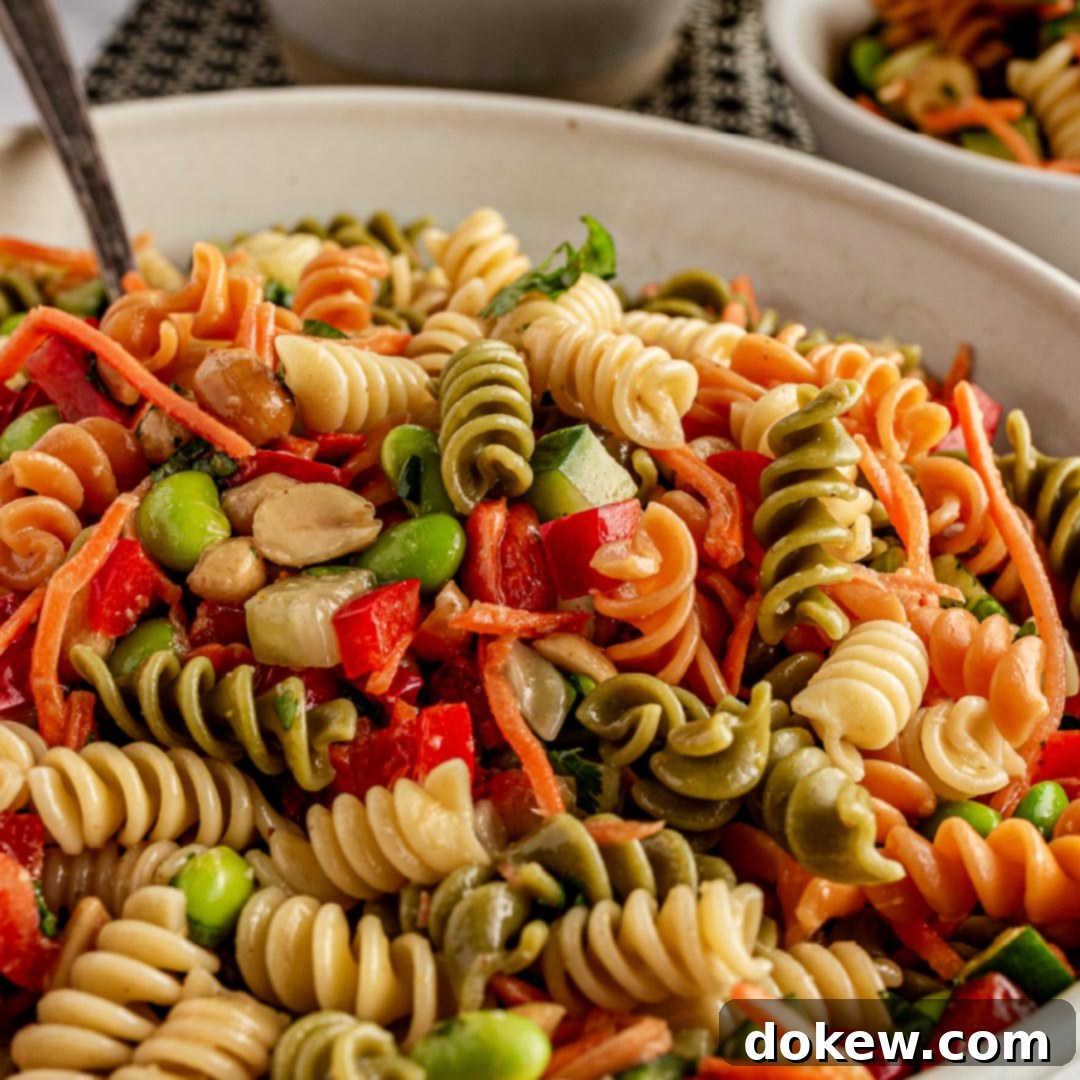Flavorful Thai Pasta Salad with Homemade Sesame Ginger Dressing: Your Ultimate Guide
Discover the vibrant flavors of Thailand beautifully encapsulated in this delightful Thai Pasta Salad, perfectly balanced with a luscious homemade Sesame Ginger Dressing. This incredibly easy-to-make dish is a symphony of colors, textures, and tastes, making it an ideal side for any meal or a light, satisfying main course. Featuring crunchy carrots, crisp red bell pepper, tender edamame, and a generous sprinkle of peanuts, all tossed with spiral pasta and generously coated in a zesty, creamy ginger dressing. Forget bland salads; this Thai peanut pasta salad promises an impressive culinary experience that’s both refreshing and utterly delicious. Whether you’re planning a casual family dinner, a lively potluck, or a sophisticated gathering, this salad is sure to be a crowd-pleaser, delivering authentic Asian-inspired flavors with every bite that will leave everyone asking for the recipe. It’s a fantastic way to bring exotic flair to your table with minimal effort.
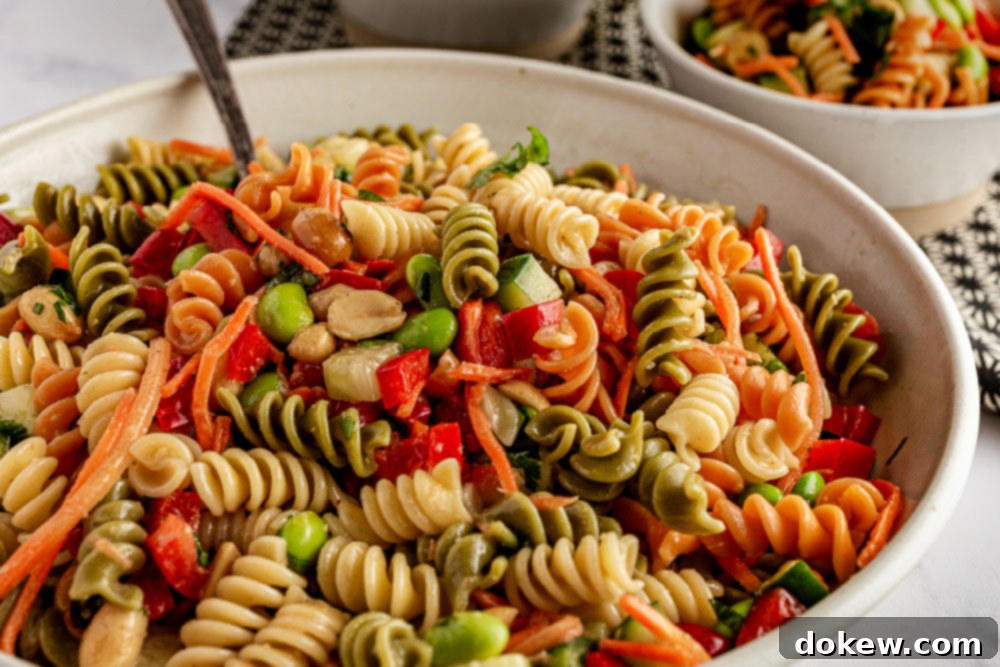
Watch How to Make Thai Pasta Salad
To help you visualize each step and ensure your Thai Pasta Salad turns out perfectly, we’ve prepared a comprehensive video tutorial. Watch as we guide you through preparing the vibrant vegetables, crafting the silky-smooth sesame ginger dressing, and combining all the elements into this incredible dish. It’s a great way to build confidence in the kitchen and see firsthand just how simple and rewarding this recipe truly is!
Essential Ingredients for Your Thai Pasta Salad
Crafting this vibrant Thai Pasta Salad begins with selecting fresh, quality ingredients for both the rich sesame ginger dressing and the colorful pasta medley. Each component plays a crucial role in building the dish’s distinct flavor profile and satisfying texture. From the aromatic ginger to the crisp vegetables and hearty pasta, gather these essentials to create a salad that’s not only visually appealing but also bursting with authentic Thai-inspired tastes. Opt for the freshest produce available to maximize the flavor and nutritional value of your salad.
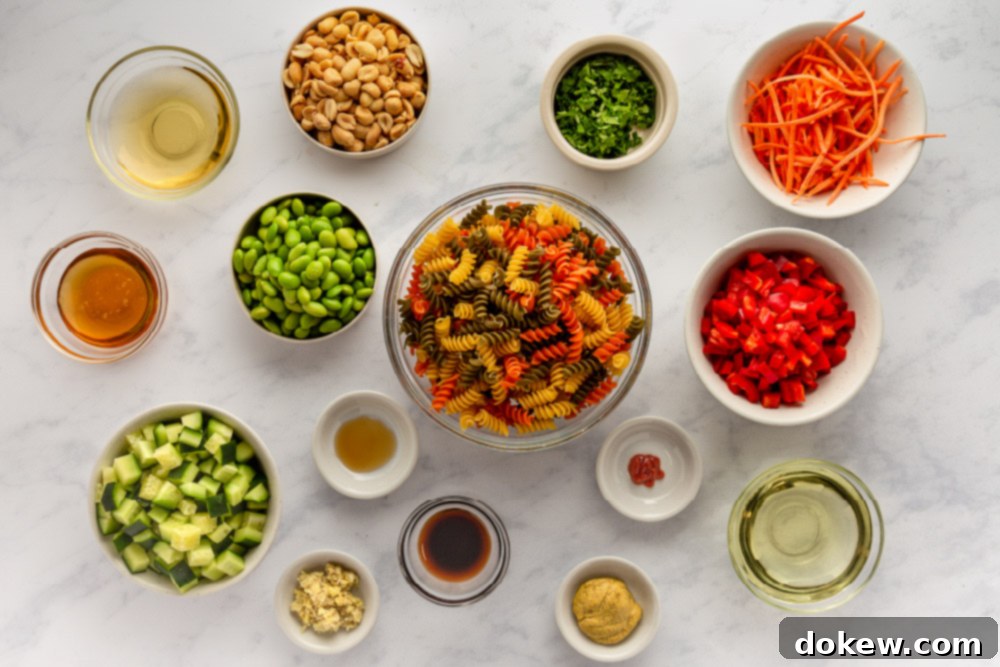
For the Sesame Ginger Dressing
This homemade dressing is the heart of the salad, offering a perfect balance of sweet, savory, and tangy notes with a kick of fresh ginger. Ensure you have these items on hand for a truly exceptional flavor.
- Vegetable Oil: Provides a smooth base for the dressing.
- Rice Wine Vinegar: Adds a crucial tangy, sweet, and mild acidic component.
- Tamari or Soy Sauce: Delivers umami depth and savory richness. Tamari is an excellent gluten-free option.
- Dijon Mustard: Acts as an emulsifier and adds a subtle piquant flavor.
- Freshly Grated Ginger: The star of the dressing, offering a warm, spicy, and aromatic essence. Adjust the quantity to your preference for ginger intensity.
- Honey: Balances the acidity and saltiness with natural sweetness.
- Toasted Sesame Oil: Essential for that distinctive nutty, toasted sesame aroma and flavor that defines many Asian dishes.
- Sriracha Hot Sauce: Provides a hint of heat and subtle chili flavor. You can adjust this to make it milder or spicier.
For the Thai Pasta Salad
The vibrant medley of vegetables and pasta creates an enticing texture and visual appeal, making this salad a feast for the senses. These ingredients ensure a fresh, satisfying crunch in every bite.
- Diced Cucumber: Offers a refreshing, crisp texture and cool flavor.
- Diced Red Bell Pepper: Adds a sweet crunch and a beautiful pop of color.
- Shredded Carrots: Contributes natural sweetness and vibrant orange hues.
- Whole Cocktail Peanuts: Essential for that satisfying crunch and classic Thai-inspired nutty flavor.
- Finely Chopped Fresh Cilantro Leaves: Provides a burst of fresh, herbaceous flavor that complements the Asian profile.
- Steamed and Shelled Edamame: Adds a touch of plant-based protein, a slightly sweet taste, and a chewy texture.
- Tri-Color Rotini: The spiral shape is perfect for catching and holding the dressing, while the tri-color adds visual interest. Any short pasta shape can be substituted.
Step-by-Step: Crafting Your Delicious Thai Pasta Salad
Preparing this Thai Pasta Salad is straightforward and incredibly rewarding. Follow these simple steps to bring together a harmonious blend of flavors and textures that will impress your taste buds and your guests. The process is divided into making the dressing and assembling the salad, allowing for efficient preparation.
Preparing the Sesame Ginger Dressing
Achieving the perfect creamy texture for your Sesame Ginger Dressing is key to this salad’s success. While it’s incredibly simple, using the right tools can make all the difference. An immersion blender is highly recommended for creating a beautifully emulsified dressing that won’t separate, ensuring a consistent burst of flavor in every bite. If an immersion blender isn’t available, a regular blender will also work effectively to achieve that smooth consistency. Avoid using a whisk, as it typically won’t achieve the stable emulsion needed for this dressing, resulting in a less cohesive texture that might separate over time.
This dressing is so versatile and delicious that you can easily make it ahead of time. Store it in an airtight container in the refrigerator for up to 4 days, making your salad assembly even quicker on busy days. The flavors will only deepen and meld beautifully with a little time.
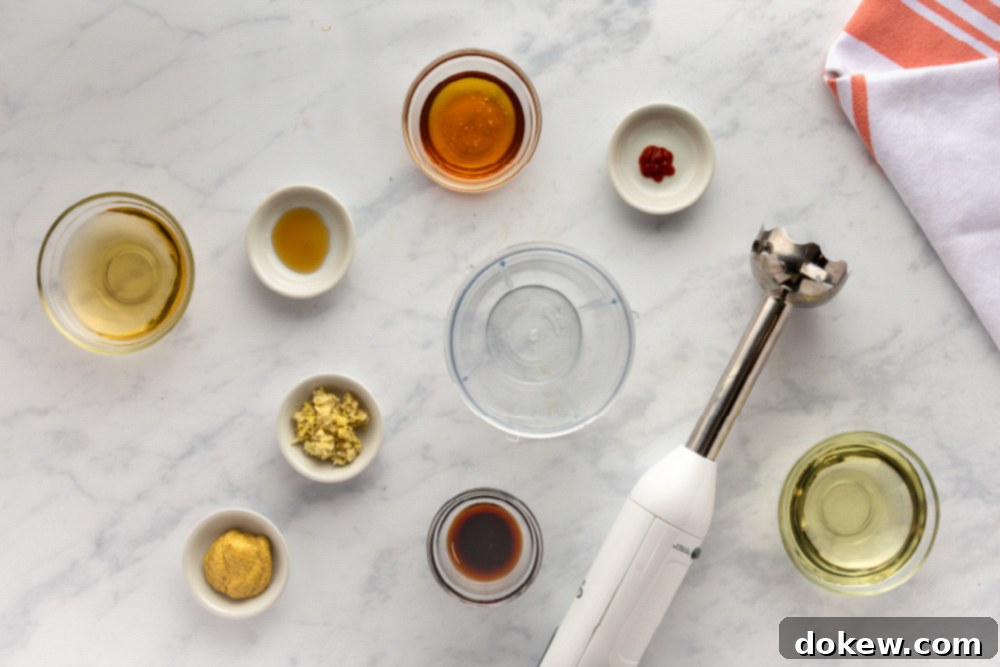
Combine all of the dressing ingredients—vegetable oil, rice wine vinegar, tamari or soy sauce, Dijon mustard, freshly grated ginger (to taste), honey, toasted sesame oil, and sriracha hot sauce—in your immersion blender container or a regular blender carafe. Blend for 1-2 minutes continuously until the mixture has fully emulsified into a smooth, creamy, and consistent consistency. The dressing should be well combined with no separation of ingredients.
Assembling the Thai Pasta Salad
Preparing the pasta and vegetables is straightforward, but attention to detail ensures the best texture and flavor. This section covers everything from cooking the pasta to combining all the fresh ingredients with our delectable dressing.
Begin by cooking your tri-color rotini pasta according to the package directions. Aim for an al dente texture, as the pasta will continue to soften slightly when combined with the dressing. Avoid overcooking, which can lead to mushy pasta in your cold salad.
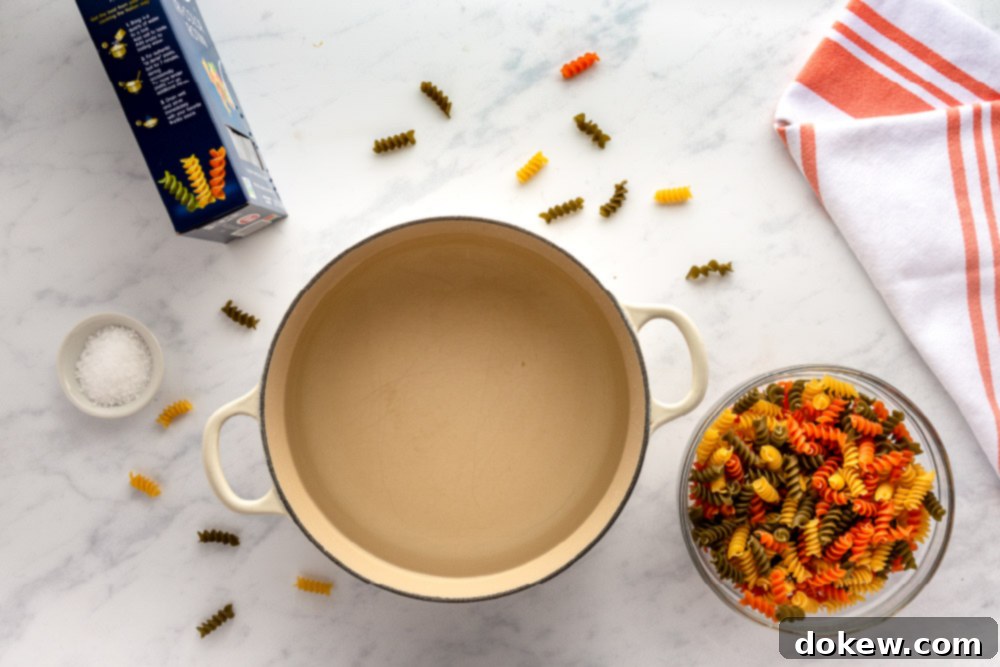
While the rotini is cooking, take this time to prepare your fresh vegetables and other mix-ins. Dice the cucumber and red bell pepper into small, uniform, bite-sized pieces. Finely chop the fresh cilantro leaves to release their aromatic essence. Steam and shell the edamame, allowing them to cool completely. These vibrant ingredients not only add flavor and texture but also make the salad visually stunning. Combine the prepared vegetables, along with the shredded carrots, whole cocktail peanuts, cilantro, and cooled edamame, in a large mixing bowl equipped with a lid.
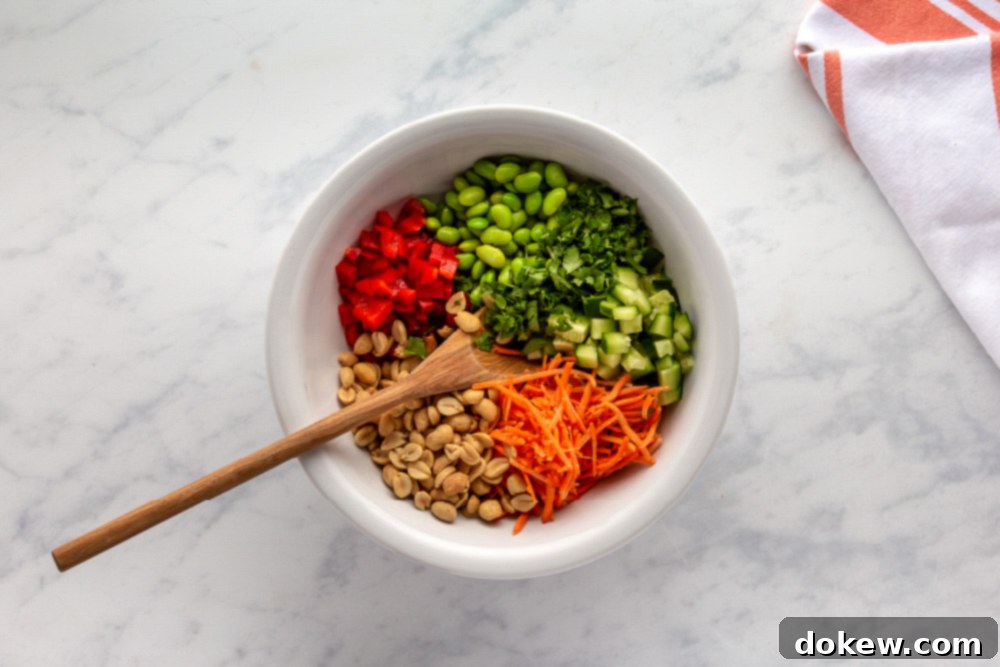
Once the rotini is cooked, immediately drain it in a colander or strainer. Crucially, rinse the pasta thoroughly with cold water until it is cool to the touch. This essential step halts the cooking process, prevents the pasta from sticking together, and removes excess starch, ensuring each spiral remains distinct and firm in your cold salad. Ensure the pasta is drained exceptionally well to prevent a watery dressing.
Add the thoroughly drained and cooled pasta to the bowl with the prepared vegetables and peanuts. Toss gently to combine all the solid ingredients evenly before introducing the dressing. This preliminary toss ensures a good distribution.
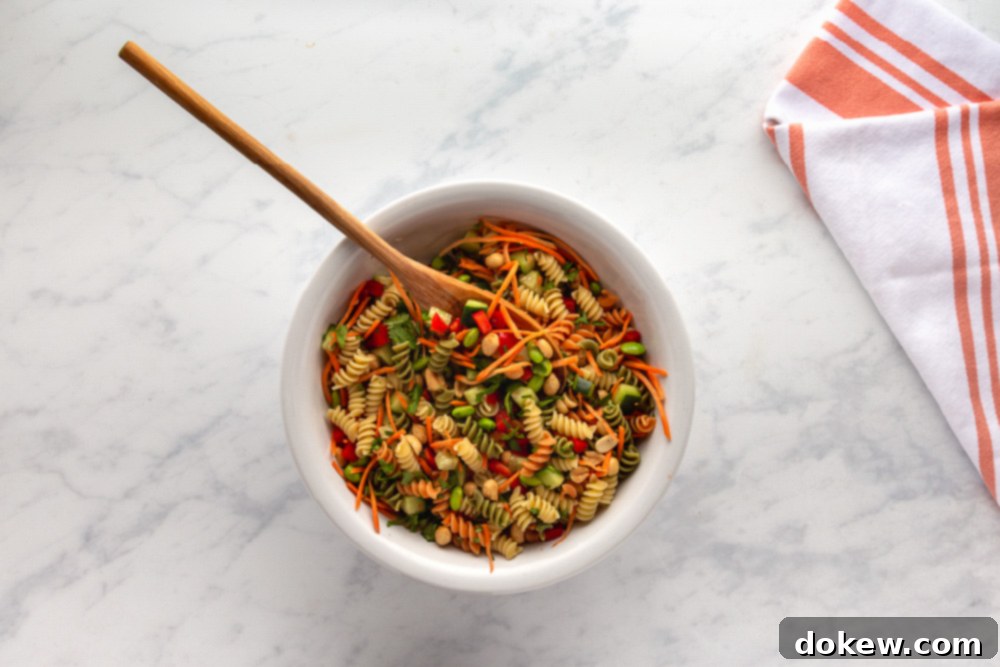
Now, pour your freshly made (or pre-made) sesame ginger dressing generously over the pasta and vegetable mixture. Mix everything thoroughly and gently, ensuring every piece of pasta and every vegetable is evenly coated in the rich, savory, and aromatic dressing. This step is vital for a consistent and delightful flavor in every forkful.
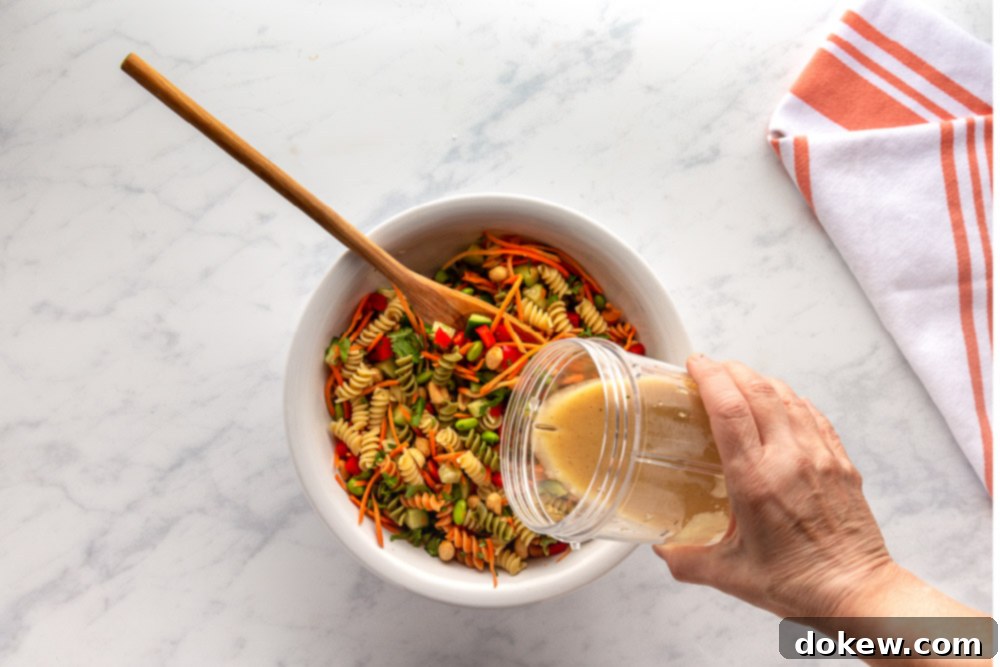
For the best results and to allow the flavors to truly meld and deepen, refrigerate the finished salad for 1-2 hours or until it’s perfectly chilled and ready to serve. If you are preparing this delightful salad more than two hours in advance, a helpful tip to maintain optimal freshness and prevent sogginess is to refrigerate the salad ingredients and the dressing separately in airtight containers. Then, simply combine them 1-2 hours before you intend to serve, ensuring the pasta remains perfectly textured and the vegetables retain their crispness.
Frequently Asked Questions About Thai Pasta Salad
Here are some common questions and helpful answers to ensure your Thai Pasta Salad with Sesame Ginger Dressing is nothing short of perfection.
Edamame (pronounced ed-uh-mah-mey) refers to young, immature soybeans still in their pods. A staple in East Asian cuisine, they are typically prepared by lightly steaming or boiling them in salted water before serving. You’ll often find them served in the pod as a popular snack, where you pop the vibrant green beans directly into your mouth. Alternatively, they can be shelled and added to various dishes, including salads, stir-fries, and grain bowls, offering a boost of plant-based protein and fiber. In the context of this Thai Pasta Salad, shelled edamame adds a wonderful pop of color, a slightly sweet, nutty flavor, and a satisfying chewy texture. To prepare them for this recipe, simply steam the edamame until tender-crisp (usually 5-7 minutes for frozen shelled edamame), then shell if necessary, and rinse them with cold water to cool them down completely before incorporating them into the salad mixture. This ensures they maintain their bright green color and firm texture within the salad.
Tamari is a premium Japanese soy sauce that distinguishes itself from conventional soy sauce primarily by its production method and gluten content. Traditionally, tamari is a byproduct of miso paste fermentation and contains little to no wheat, making many brands, such as San-J, entirely gluten-free. It boasts a richer, darker color and a more nuanced, less salty flavor compared to standard soy sauce. Its depth of umami makes it an excellent choice for dressings and sauces where its distinct flavor can shine without overwhelming other ingredients. While generally more expensive and sometimes harder to find in generic store brands than regular soy sauce, its superior flavor and gluten-free nature (for those with dietary restrictions) make it a worthwhile investment for this recipe. For smaller quantities, like in dressings, tamari is preferred; however, for recipes requiring larger volumes, such as marinades, a high-quality regular soy sauce can be a suitable substitute if gluten is not a concern.
Fresh ginger root is a powerful aromatic ingredient that adds a warm, spicy, and fragrant kick to this dressing. You’ll typically find it in the produce section of your grocery store. To prepare it for grating, first, peel off the dry, papery skin to expose the moist, fibrous root underneath. A vegetable peeler works well for this, or even the edge of a spoon for those trickier, knobby parts. I recommend peeling only the portion you intend to use and keeping the rest unpeeled, storing it in the refrigerator (or freezer for longer preservation) for future use. To grate, you can use the small holes of a standard box grater, but for the finest texture and maximum flavor extraction, a microplane grater is ideal. Hold the unpeeled end of the ginger root firmly and push the peeled portion across the grating surface over a bowl to catch the grated ginger. Periodically scrape any accumulated ginger from the back of the grater to clear the holes and ensure you capture all the flavorful pulp and juice. The amount of ginger can be adjusted to your personal preference; some enjoy a stronger ginger presence, while others prefer a subtler hint.
Yes, Thai Pasta Salad is an excellent choice for meal prep or for preparing ahead of a gathering! However, to ensure the best texture and prevent the pasta from absorbing too much dressing and becoming soggy, it’s recommended to store the components separately if you plan to make it more than two hours before serving. This means keeping the cooked and cooled pasta, the prepared vegetables (cucumber, bell pepper, carrots, edamame, cilantro), and the sesame ginger dressing in individual airtight containers in the refrigerator. Then, approximately 1-2 hours before you plan to serve, combine all the ingredients and toss them with the dressing. This method allows the flavors to meld beautifully without compromising the integrity of the pasta or the crispness of the vegetables, ensuring a fresh and delicious salad experience every time. A quick toss before serving will redistribute the dressing and freshen up the salad.
The base recipe for this Thai Pasta Salad with Sesame Ginger Dressing offers a very mild, subtle spice kick from the sriracha, making it palatable for most palates, including those sensitive to heat. However, if you’re a fan of bolder heat and want to elevate the spice level, there are several delicious ways to customize it. You can easily increase the amount of sriracha hot sauce in the dressing to your liking. For a different type of heat, consider adding a pinch or two of crushed red pepper flakes to the dressing or directly into the salad. For a more authentic Thai heat, a touch of red curry paste or a drizzle of chili oil would also be fantastic additions, providing both flavor and warmth. Always add these in small increments and taste as you go to achieve your desired level of spiciness, building up to your perfect heat level.
Absolutely! While tri-color rotini offers a fun visual appeal and great texture for holding the dressing, this recipe is incredibly versatile when it comes to pasta choice. You can substitute any other short pasta shape that you prefer, such as fusilli, penne, farfalle (bow-tie), or even elbow macaroni. The key is to choose a shape that can effectively capture the dressing. For a more authentic Asian noodle salad experience, consider using soba noodles (buckwheat noodles) for a nutty flavor, or rice noodles (vermicelli or broader flat rice noodles) which are commonly found in Thai cuisine and offer a different texture profile. Just ensure to cook any alternative pasta or noodles according to their specific package directions and cool them properly before mixing to prevent clumping and ensure the best salad texture.
Making this Thai Pasta Salad gluten-free is very achievable with just a couple of simple substitutions. The primary gluten-containing ingredients in a standard pasta salad would be the pasta itself and traditional soy sauce. To make it entirely gluten-free, opt for a certified gluten-free pasta, such as a rice-based pasta or corn-based pasta, which are widely available in most grocery stores. Alternatively, as mentioned previously, you can use naturally gluten-free noodles like soba (ensure it’s 100% buckwheat, as some contain wheat) or rice noodles. Crucially, replace regular soy sauce with gluten-free tamari (many brands are specifically labeled gluten-free, like San-J) or a gluten-free soy sauce alternative. Always double-check the labels of all other ingredients, especially sauces and condiments, to ensure they don’t contain hidden gluten. With these modifications, you can enjoy a delicious and worry-free gluten-free Thai Pasta Salad.
For those with peanut allergies or who simply prefer to avoid peanuts, adapting this Thai Pasta Salad is easy and doesn’t compromise on flavor. You have a couple of excellent options. The simplest method is to omit the peanuts entirely; the salad will still be incredibly flavorful and satisfying thanks to the robust dressing and array of fresh vegetables. If you’d like to maintain a similar crunchy texture and nutty flavor profile, an ideal substitute would be toasted cashews, sunflower seeds, or even toasted pumpkin seeds (pepitas). Just ensure that any alternative nuts or seeds you use are safe for your specific dietary needs and free from cross-contamination if severe allergies are a concern. This flexibility ensures everyone can enjoy a delightful version of this vibrant salad.
While I personally prefer the nuanced flavors of this pasta salad without the sharp intensity of raw onion, adding it is certainly an option if you enjoy it and feel it would enhance the dish for your palate. If you choose to incorporate onion, I would recommend either finely chopped red onion for a bolder, slightly pungent bite that also adds a beautiful color contrast, or thinly sliced green onions (scallions) for a milder, fresher onion flavor. Both would complement the existing ingredients well. If using red onion, you might consider soaking it in cold water for 10-15 minutes after chopping to mellow its intensity slightly before adding it to the salad. This trick helps to reduce its sharp edge, making it more pleasant in a raw salad.
Full Recipe Details
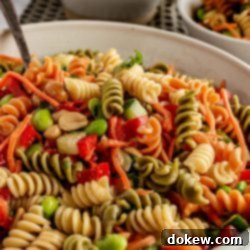
Thai Pasta Salad with Sesame Ginger Dressing
Add to Shopping ListGo to Shopping List
Equipment
-
Immersion Blender (or a standard blender)
-
Large Mixing Bowl with Lid
-
Saucepan (for pasta)
-
Colander or Strainer
-
Microplane Grater (for ginger)
Ingredients
Sesame Ginger Dressing
- ¾ cup vegetable oil
- 4½ tablespoons rice wine vinegar
- 2¼ tablespoons tamari or soy sauce
- 1½ tablespoons Dijon mustard
- 1 to 3 tablespoons fresh ginger, grated (adjust to taste for desired ginger intensity)
- 3¾ tablespoons honey
- ⅓ teaspoon toasted sesame oil
- ⅓ teaspoon sriracha hot sauce (or more for extra spice)
Thai Pasta Salad
- 1 cup cucumber, diced into small, uniform pieces
- 1 cup red bell pepper, diced into small, uniform pieces
- ⅔ cup shredded carrots
- 1⅓ cups whole cocktail peanuts (or toasted cashews for peanut-free)
- 2 tablespoons fresh cilantro, finely chopped
- 1½ cups edamame, steamed and shelled (ensure they are cooled)
- 16 ounces tri-color rotini (or your preferred short pasta shape; use gluten-free pasta for GF option)
Instructions
For the Sesame Ginger Dressing
-
Prepare Ahead (Optional): The sesame ginger dressing is perfect for making in advance! It can be stored in an airtight container in the refrigerator for up to 4 days, allowing flavors to deepen.
-
Grate Ginger: Peel and grate 1 to 3 tablespoons fresh ginger, adjusting the amount to your preferred level of ginger intensity.
-
Combine Ingredients: In the container of an immersion blender (or a regular blender), combine the ¾ cup vegetable oil, 4½ tablespoons rice wine vinegar, 2¼ tablespoons tamari or soy sauce, 1½ tablespoons Dijon mustard, the grated ginger, 3¾ tablespoons honey, ⅓ teaspoon toasted sesame oil, and ⅓ teaspoon sriracha hot sauce. It is not recommended to use a whisk, as achieving a proper emulsification will be difficult.
-
Blend until Emulsified: Blend the mixture for 1-2 minutes until it has fully emulsified into a smooth, creamy, and consistent dressing. Set aside.
For the Thai Pasta Salad
-
Cook Pasta: Cook 16 ounces tri-color rotini according to the package directions until al dente.
-
Prepare Edamame: Steam and shell 1½ cups edamame. Once cooked, rinse with cold water and allow to cool completely.
-
Chop Vegetables: Dice 1 cup cucumber and 1 cup red bell pepper into small, uniform pieces. Finely chop 2 tablespoons fresh cilantro.
-
Combine Solid Ingredients: In a large mixing bowl with a lid, combine the diced cucumber, red bell pepper, ⅔ cup shredded carrots, 1⅓ cups whole cocktail peanuts, chopped cilantro, and cooled edamame.
-
Cool Pasta: When the rotini is done, drain it thoroughly in a colander and rinse with cold water until the pasta is cool to the touch. This stops the cooking process and prevents sticking.
-
Add Pasta: Drain the cooled pasta exceptionally well to remove any excess water. Add the pasta to the vegetables in the large bowl and toss gently to combine all the solid ingredients.
-
Dress the Salad: Pour the prepared sesame ginger dressing over the pasta and vegetables. Mix everything thoroughly and gently until all ingredients are evenly coated in the dressing.
-
Chill and Serve: For the best flavor development, refrigerate the salad for 1-2 hours or until it is well chilled and ready to serve. If preparing more than two hours in advance, store the dressing and salad ingredients separately in airtight containers in the refrigerator, and combine them 1-2 hours before serving to maintain optimal freshness and texture.
Nutrition per serving
Share
Pin
